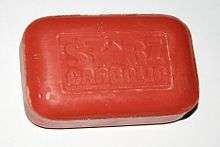Carbolic soap
Carbolic soap, sometimes referred to as red soap, is a mildly antiseptic soap containing carbolic acid and/or cresylic acid, both of which are phenols derived from either coal tar or petroleum sources.[1][2]

In 1834, German chemist Friedlieb Ferdinand Runge discovered a phenol, now known as carbolic acid, which he derived in an impure form from coal tar. In August 1865, Dr. Joseph Lister, 1st Baron Lister applied a piece of lint dipped in carbolic acid solution to the wound of an eleven-year-old boy at Glasgow Royal Infirmary, who had sustained a compound fracture after a cart wheel had passed over his leg. After four days, he renewed the pad and discovered that no infection had developed, and after a total of six weeks he was amazed to discover that the boy's bones had fused back together, without the danger of suppuration.[3][4] In 1894, William Lever, 1st Viscount Leverhulme introduced the first mass-produced carbolic soap to the market, Lifebuoy.[5]
One of the distinctive features of this soap is its deep pink to red color, which was and still is added to the soap to designate it as Carbolic Soap. The addition of the red color was deemed important due to the fact that when Carbolic Soap was first introduced to the general public it was the only germicidal soap available. Carbolic acid is used in a wide range of industrial and consumer product applications and can be a skin irritant.[6] Some people who use a great deal of carbolic soap might find that their skin becomes irritated as a result of prolonged contact. This is one of the reasons carbolic soap has been displaced in hospitals by more gentle disinfectant skin cleansers.
By killing bacteria, it also acts as a mild deodorant when used as a body soap. It is still distributed to disaster victims for routine hygiene by the Red Cross and other relief organizations.[7]
Remembered by generations of people from the 1920s through to the 1970s as the household soap of their childhood, it is still sought after by some for its nostalgic strong, tar-like scent and bright pinkish-red colour. In Great Britain it was used in state schools at least up until the late 1980s.
Carbolic soap is still used in the Caribbean region, especially Jamaica and Panama where it can be found in pharmacies and supermarkets.
See also
References
- W. H. Simmons and H. A. Appleton, The Handbook of Soap Manufacture, Echo Library, 2007, p. 104.
- "Definition of carbolic soap". Allwords.com. 2007-03-29. Retrieved 2010-08-19.
- "Cresylic acid | chemical compound".
- Lister, Joseph (21 September 1867). "On the Antiseptic Principle in the Practice of Surgery". The Lancet. 90 (2299): 353–356. doi:10.1016/s0140-6736(02)51827-4.
- Lister, Joseph (1 January 1870). "On the Effects of the Antiseptic System of Treatment Upon the Salubrity of a Surgical Hospital". The Lancet. 95 (2418): 2–4. doi:10.1016/S0140-6736(02)31273-X.
- "Country Selector". Archived from the original on 2014-10-06. Retrieved 2014-10-16. A History of Health, lifebuoy.com
- "ATSDR - Medical Management Guidelines (MMGs): Phenol". www.atsdr.cdc.gov. Retrieved 2018-09-02.
- "ReliefWeb ť Document ť West Africa Appeal No. 01.02/2001 Programme Update No. 2". Reliefweb.int. Retrieved 2010-08-19.
- "Village Education Resource Center". VERC. Retrieved 2010-08-19.